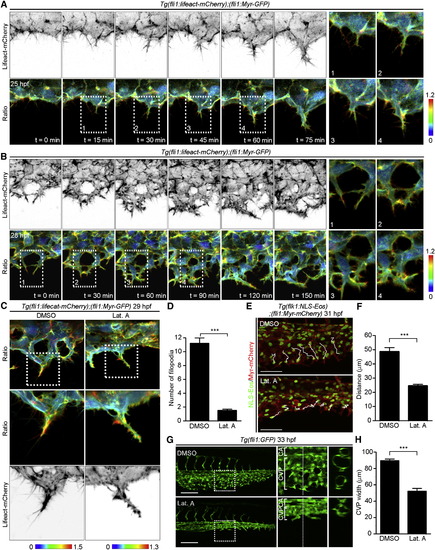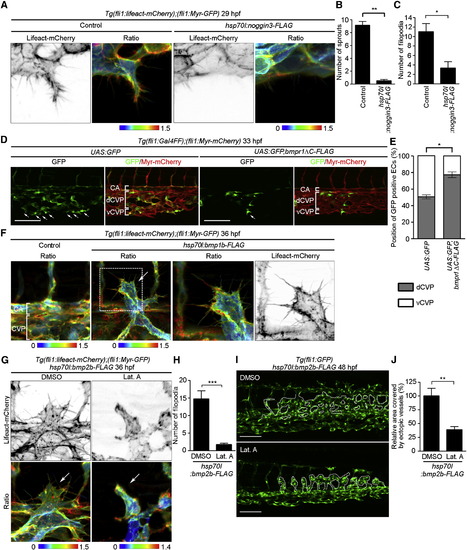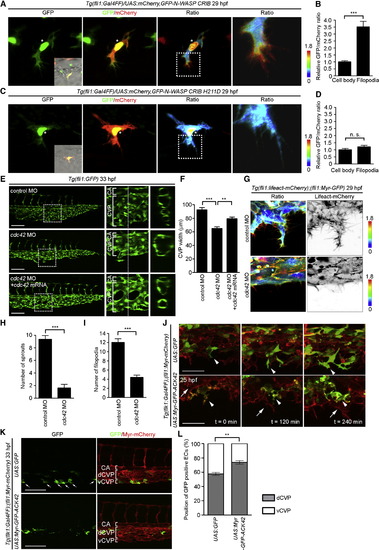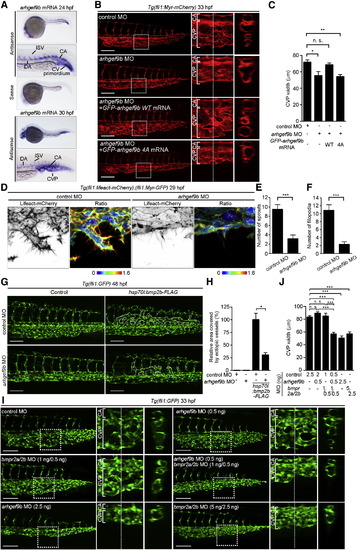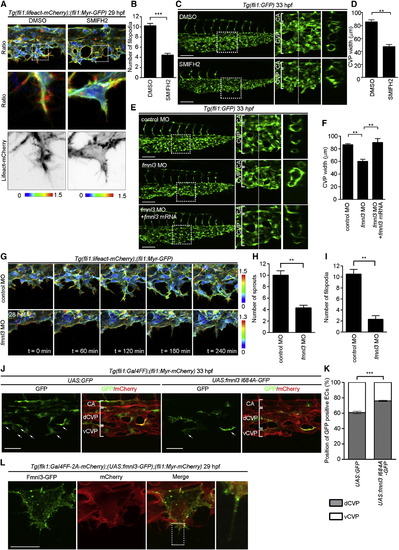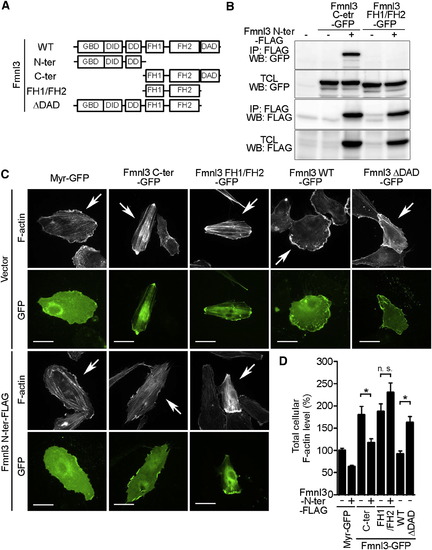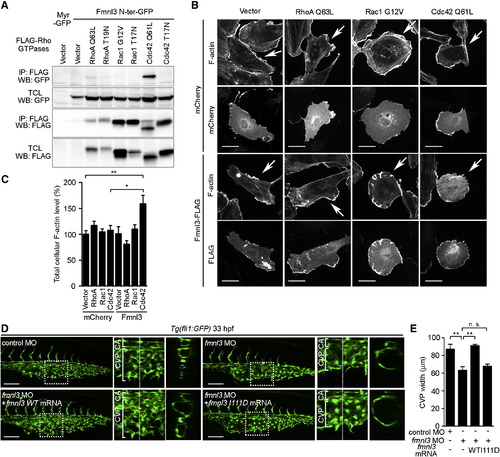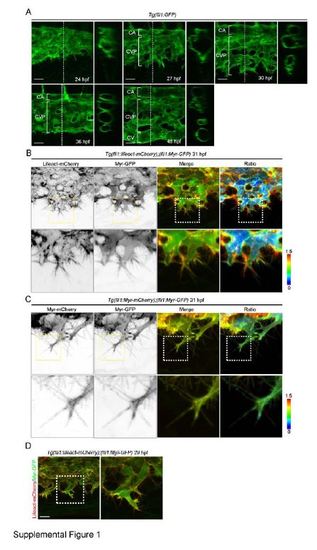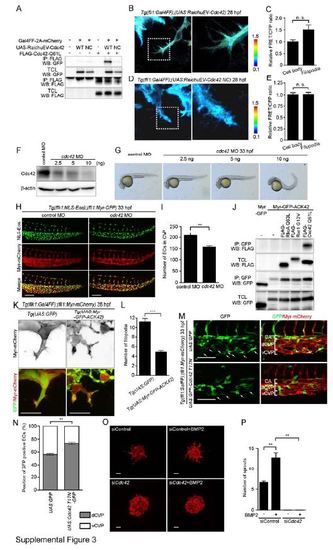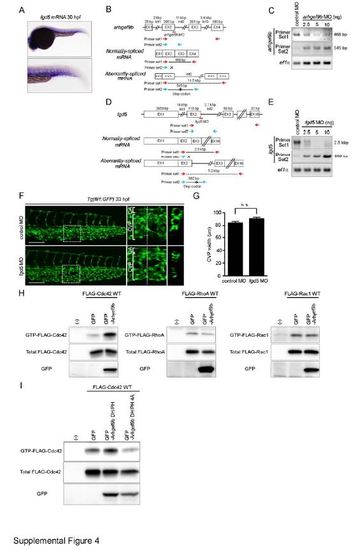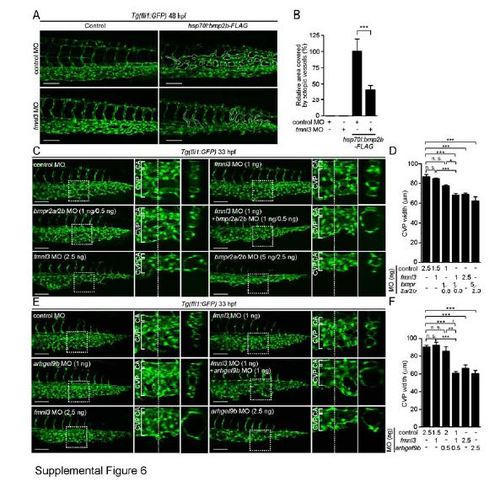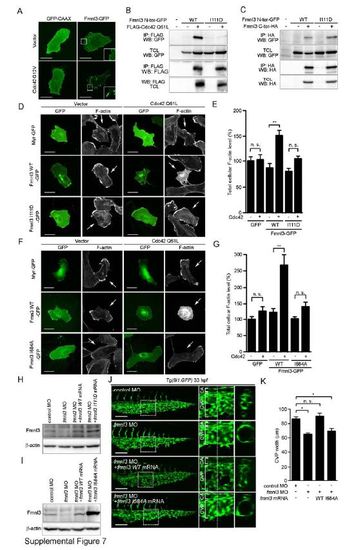- Title
-
Cdc42 Mediates Bmp-Induced Sprouting Angiogenesis through Fmnl3-Driven Assembly of Endothelial Filopodia in Zebrafish
- Authors
- Wakayama, Y., Fukuhara, S., Ando, K., Matsuda, M., Mochizuki, N.
- Source
- Full text @ Dev. Cell
|
Filopodia Are Required for EC Migration during CVP Formation (A and B) 3D-rendered confocal images of the CVP of Tg(fli1:lifeact-mCherry);(fli1:Myr-GFP) embryos at 25 hpf (A) and 28 hpf (B) and their subsequent time-lapse images at the indicated time points. Upper row: mCherry images (intensity of Lifeact-mCherry is shown as a grayscale image); lower row, mCherry/GFP ratio images shown in the IMD mode (Ratio). The upper and lower limits of the ratio range are indicated on the right. The boxed areas labeled with numbers 1–4 are enlarged on the right side. (C) 3D-rendered confocal images of the CVP of Tg(fli1:lifeact-mCherry);(fli1:Myr-GFP) embryos treated with DMSO or 0.1 µg/ml Lat. A from 26 to 29 hpf. Top: ratio images of mCherry/GFP; middle: enlarged images of the boxed areas; bottom: enlarged mCherry images of the boxed areas. The upper and lower limits of the ratio range are indicated on the bottom. (D) The number of filopodia for each EC located at the vascular front, as observed in (C), was quantified as described in the Experimental Procedures and shown as the mean ± SEM (DMSO, n = 10; Lat. A, n = 12). (E) Projection view of confocal z stack images of the CVP of Tg(flk1:NLS-Eos);(fli1:Myr-mCherry) embryos treated with DMSO or Lat. A from 25 to 31 hpf. The merged images of Eos (green) and mCherry (red) are superimposed on the migration paths of ECs (white lines) inferred from time-lapse confocal movies taken from 25 to 31 hpf. (F) The EC migration distance, as observed in (E), was quantified and is shown as the mean ± SEM (DMSO, n = 6; Lat. A, n = 6). (G) Projection view of confocal z stack images of the caudal regions of Tg(fli1:GFP) embryos treated with DMSO or Lat. A from 24 to 33 hpf. The boxed areas in the left panel are enlarged in the middle panel. The cross-sectional single-plane images of the areas indicated by dotted lines on the enlarged images are shown in the right column. CA, caudal artery. (H) The CVP width, as observed in (G), was quantified and is shown as the mean ± SEM (DMSO, n = 8; Lat. A, n = 8). Scale bars, 50 µm in (E) and (G). All zebrafish images are shown dorsal to the top and anterior to the left, unless otherwise described. p < 0.001. See also Figure S1 and Movies S1, S2, and S3. |
|
Bmp Induces EC to Extend into Filopodia during CVP Formation (A) 3D-rendered confocal 3D images of the CVP of 29 hpf Tg(fli1:lifeact-mCherry);(fli1:Myr-GFP) embryos injected without (Control) or with hsp70l:noggin3-FLAG-Tol2 plasmid and heat shocked at 22 hpf for 24 hr are shown as in Figure 1A. (B) The total number of sprouts extending from the CV primordia, as observed in (A), was counted and is shown as the mean ± SEM (Control, n = 5; hsp70l:noggin3-FLAG, n = 4). (C) The number of filopodia for each EC located at the vascular front, as observed in (A), was quantified as in Figure 1D (Control, n = 5; hsp70l:noggin3-FLAG, n = 4). Error bars indicate means ± SEM. (D) Projection view of confocal z stack images of the caudal regions of 33 hpf Tg(fli1:Gal4FF);(fli1:Myr-mCherry) embryos injected with UAS:GFP Tol2 vector (UAS:GFP) or UAS:GFP,bmpr1ΔC-FLAG Tol2 plasmid (UAS:GFP,bmpr1ΔC-FLAG). Left, GFP images; right, the merged images of GFP (green) and mCherry (red). Arrows indicate GFP-expressing ECs that localize in the ventral part of CVP. CA, caudal artery; dCVP, dorsal part of CVP; vCVP, ventral part of CVP. (E) Percentages of GFP-expressing ECs localizing in the dCVP or vCVP, as observed in (D), are shown as means ± SEM (UAS:GFP, n = 6; UAS:GFP, bmpr1ΔC-FLAG, n = 5). (F) 3D-rendered confocal images of the caudal regions of 36 hpf Tg(fli1:lifeact-mCherry);(fli1:Myr-GFP) embryos injected without (Control, left panel) or with hsp70l:bmp2b-FLAG Tol2 plasmid (right three panels) and heat shocked at 24 hpf for 30 min are shown as in Figure 1A. The mCherry/GFP ratio and mCherry images of the boxed area are enlarged in the third and fourth panels from the left, respectively. Arrow indicates ectopic venous vessels. (G) 3D-rendered confocal images of the caudal regions of 36 hpf Tg(fli1:lifeact-mCherry);(fli1:Myr-GFP) embryos injected with hsp70l:bmp2b-FLAG Tol2 plasmid, heat shocked at 24 hpf for 30 min and treated with DMSO or Lat. A from 29 to 33 hpf are shown as in Figure 1A. Arrows indicate ectopic venous vessels. (H) The number of filopodia for each EC located at the front of ectopic vessels, as observed in (G), was quantified as in Figure 1D (DMSO, n = 7; Lat. A, n = 7). Error bars indicate means ± SEM. (I) Projection view of confocal z stack images of the caudal regions of 48 hpf Tg(fli1:GFP) embryos injected with hsp70l:bmp2b-FLAG Tol2 plasmid, heat shocked at 24 hpf for 30 min, and treated with DMSO or Lat. A from 33 to 48 hpf. Dotted lines indicate ectopic venous vessels. (J) The areas covered by ectopic venous vessels as observed in (I) were quantified and expressed as percentages relative to that observed in DMSO-treated embryos. Data are shown as means ± SEM (DMSO, n = 5; Lat. A, n = 5). Scale bars, 100 µm in (D) and (I). p < 0.05; p < 0.01; p < 0.001. See also Figure S2 and Movie S4. EXPRESSION / LABELING:
|
|
Cdc42 Mediates EC Extension into Filopodia during CVP Formation (A) 3D-rendered confocal images of the ECs in the CVP of 29 hpf Tg(fli1:Gal4FF) embryos injected with UAS:mCherry,GFP-N-WASP CRIB Tol2 plasmid. The GFP image, the merged image of GFP (green) and mCherry (red) (GFP/mCherry), and the GFP/mCherry ratio image, in the IMD mode (Ratio), are shown as indicated at the top. The boxed area in the Ratio image is enlarged on the far right side. The inset in the GFP image is the single-scan merged image of differential interference contrast GFP and mCherry images. The upper and lower limits of the ratio range are indicated on the right. Note that accumulation of GFP-N-WASP CRIB in the nucleus indicated by asterisks does not reflect localization of GTP-Cdc42, since its mutant, which is incapable of binding GTP-bound Cdc42 (GFP-N-WASP CRIB H211D), was also accumulated in the nucleus as shown in (C). (B) Relative GFP/mCherry ratio (localization of GTP-Cdc42) in the filopodia and cell bodies of ECs located at the vascular front in the CVP, as observed in (A), was expressed as the fold increase relative to that observed in the cell body. Data are shown as means ± SEM (n = 15). (C) 3D-rendered confocal images of the EC in the CVP of 29 hpf Tg(fli1:Gal4FF) embryos injected with UAS:mCherry,GFP-N-WASP CRIB H211D Tol2 plasmid are shown as in (A). (D) Relative GFP/mCherry ratio in the filopodia and cell bodies of ECs located at the vascular front in the CVP, as observed in (C), is shown as in (B) (n = 13). Error bars indicate means ± SEM. (E) Projection view of confocal z stack images of the caudal regions of 33 hpf Tg(fli1:GFP) embryos injected with 5 ng control MO (upper panel), 5 ng cdc42 MO (middle panel), and 5 ng cdc42 MO together with 100 pg MO-resistant cdc42 mRNA (lower panel) are shown as in Figure 1G. (F) The CVP width, as observed in (E), was quantified and is shown as the mean ± SEM (control MO, n = 6; cdc42 MO, n = 5; cdc42 MO + cdc42 mRNA, n = 5). (G) 3D-rendered confocal images of the CVP of 29 hpf Tg(fli1:lifeact-mCherry);(fli1:Myr-GFP) embryos injected with 5 ng control MO (upper panels) and 5 ng cdc42 MO (lower panels) are shown as in Figure 1A. (H) The number of sprouts extending from the CV primordia, as observed in (G), was quantified as in Figure 2B (control MO, n = 6; cdc42 MO, n = 5). Error bars indicate means ± SEM. (I) The number of filopodia for each EC located at the vascular front, as observed in (G), was quantified as in Figure 1D (control MO, n = 10; cdc42 MO, n = 11). Error bars indicate means ± SEM. (J) Projection view of confocal z stack images of the CVP of Tg(flk1:Gal4FF-2A-mCherry);(fli1:Myr-mCherry) embryos injected with UAS:GFP-Tol2 plasmid or UAS:Myr-GFP-ACK42-Tol2 plasmid at 28 hpf and subsequent time-lapse images at the indicated time points. The merged images of GFP (green) and mCherry (red) are shown. Arrowheads and arrows indicate GFP-positive and GFP-negative ECs, respectively. Note that Myr-GFP-ACK42-expressing ECs failed to migrate during CVP formation. (K) Projection views of confocal z stack images of the caudal regions of 33 hpf Tg(flk1:Gal4FF-2A-mCherry);(fli1:Myr-mCherry) embryos injected with UAS:GFP Tol2 plasmid or UAS:Myr-GFP-ACK42 Tol2 plasmid are shown as in Figure 2D. (L) Percentages of GFP-expressing or Myr-GFP-ACK42-expressing ECs localized in the dorsal part of the CVP (dCVP) or the ventral part of the CVP (vCVP), as observed in (K), are shown as means ± SEM (GFP, n = 8; Myr-GFP-ACK42, n = 9). Scale bars, 100 µm in (E) and (K) and 50 µm in (J). p < 0.01; p < 0.001; n.s., no significance. See also Figure S3 and Movie S5. |
|
Arhgef9b, a Cdc42 GEF, Is Involved in Bmp-Mediated CVP Formation (A) Expression patterns of arhgef9b mRNA in zebrafish embryos at 24 and 30 hpf as detected by whole-mount in situ hybridization. The caudal region is enlarged in the lower panel. A sense probe was used to confirm the specificity of the hybridization reaction. DA, dorsal aorta; CA, caudal artery. (B) Projection views are shown of confocal z stack images of the caudal regions of 33 hpf Tg(fli1:Myr-mCherry) embryos injected with 2.5 ng control MO, 2.5 ng arhgef9b MO, and 2.5 ng arhgef9b MO, together with either 100 pg MO-resistant GFP-arhgef9b mRNA or 100 pg MO-resistant GFP-arhgef9b 4A mRNA as in Figure 1G. (C) The CVP width, as observed in (B), was quantified as in Figure 1H (control MO, n = 13; arhgef9b MO, n = 11; arhgef9b MO + GFP-arhgef9b WT mRNA [WT], n = 14; and arhgef9b MO + GFP-arhgef9b 4A mRNA [4A], n = 5). Error bars indicate means ± SEM. (D) 3D-rendered confocal images of the CVP of 29 hpf Tg(fli1:lifeact-mCherry);(fli1:Myr-GFP) embryos injected with 5 ng control MO and 5 ng arhgef9b MO are shown as in Figure 1A. (E) The number of sprouts extending from the CV primordia, as observed in (D), was quantified as in Figure 2B (control MO, n = 8; arhgef9b MO, n = 7). Error bars indicate means ± SEM. (F) The number of filopodia for each EC located at the vascular front, as observed in (D), was quantified as in Figure 1D (control MO, n = 8; arhgef9b MO, n = 7). Error bars indicate means ± SEM. (G) Projection view of confocal z stack images of the caudal regions of 48 hpf Tg(fli1:GFP) embryos injected with 2.5 ng control MO (upper panel) or 2.5 ng arhgef9b MO (lower panel), either alone (Control) or together with hsp70l:bmp2b-FLAG Tol2 plasmid. Dotted lines indicate ectopic venous vessels. (H) The areas covered by ectopic venous vessels, as observed in (G), were quantified and expressed as percentages relative to that observed in the embryos injected with both control MO and hsp70l:bmp2b-FLAG Tol2 plasmid. Data are shown as means ± SEM (each sample, n = 12). (I) Projection view of confocal z stack images of the caudal regions of 33 hpf Tg(fli1:GFP) embryos injected with control MO, both bmpr2a and bmp2rb MOs, and arhgef9b MO, as indicated in the upper left corner of each image, are shown as in Figure 1G. The amounts of injected MOs (per embryo) are also indicated in parentheses after the name of the MO. (J) The CVP width, as observed in (I), was quantified as in Figure 1H (n ≥ 5). Error bars indicate means ± SEM. Scale bars, 100 µm in (B), (G), and (I). p < 0.05; p < 0.01; p < 0.001; n.s., no significance. See also Figure S4. |
|
Fmnl3 Is Required for EC to Extend into Filopodia during CVP Formation (A) 3D-rendered confocal images of the CVP of 29 hpf Tg(fli1:lifeact-mCherry);(fli1:Myr-GFP) embryos treated with DMSO or 1 µM SMIFH2, a formin inhibitor, from 25 to 29 hpf are shown as in Figure 1A. (B) The number of filopodia for each EC located at the vascular front, as observed in (A), was quantified as in Figure 1D (DMSO, n = 10; SMIFH2, n = 12). (C) Projection view of confocal z stack images of the caudal regions of 33 hpf Tg(fli1:GFP) embryos treated with DMSO or SMIFH2 from 24 to 33 hpf are shown as in Figure 1G. (D) The CVP width, as observed in (C), was quantified as in Figure 1H (DMSO, n = 7; SMIFH2, n = 9). Error bars indicate means ± SEM. (E) Projection view of confocal z stack images of the caudal regions of 33 hpf Tg(fli1:GFP) embryos injected with 2.5 ng control MO (upper panel), 2.5 ng fmnl3 MO (middle panel), and 2.5 ng fmnl3 MO together with 100 pg MO-resistant fmnl3 mRNA (lower panel) are shown as in Figure 1G. (F) The CVP width, as observed in (E), was quantified as in Figure 1H (control MO, n = 8; fmnl3 MO, n = 6; fmnl3 MO + fmnl3 mRNA, n = 8). Error bars indicate means ± SEM. (G) 3D-rendered confocal images of the CVP of 28 hpf Tg(fli1:lifeact-mCherry);(fli1:Myr-GFP) embryos injected with 2.5 ng control MO or 2.5 ng fmnl3 MO and their subsequent time-lapse images at the indicated time points. The ratio images of mCherry/GFP are shown as in Figure 1A. (H) The number of sprouts extending from the CV primordia, as observed in (G), was quantified as in Figure 2B (control MO, n = 8; fmnl3 MO, n = 8). Error bars indicate means ± SEM. (I) The number of filopodia for each EC located at the vascular front as observed in (G) was quantified as in Figure 1D (control MO, n = 8; fmnl3 MO, n = 8). Error bars indicate means ± SEM. (J) Projection views of confocal z stack images of the caudal regions of 33 hpf Tg(fli1:Gal4FF);(fli1:Myr-mCherry) embryos injected with UAS:GFP Tol2 vector (UAS:GFP) or UAS:fmnl3 I684A-GFP Tol2 plasmid (UAS:fmnl3 I684A-GFP) are shown as in Figure 2D. (K) Percentages of GFP-expressing ECs localizing in the dorsal part of CVP (dCVP) or the ventral part of CVP (vCVP), as observed in (J), are shown as mean ± SEM (UAS:GFP, n = 3; UAS:fmnl3 I684A-GFP, n = 3). Error bars indicate means ± SEM. (L) Projection view of confocal z stack images of one of the ECs located at the vascular front of the CVP in a Tg(flk1:Gal4FF-2A-mCherry);(UAS:fmnl3-GFP);(fli1:Myr-mCherry) embryo at 29 hpf. GFP (Fmnl3-GFP) and mCherry images and the merged image (Merge) are shown as indicated at the top. The boxed area on the merged image is enlarged on the right. Scale bars, 100 µm in (C) and (E), 50 µm in (J), and 20 µm in (L). p < 0.01; p < 0.001. See also Figure S5 and Movie S6. |
|
Actin Polymerization Activity of Fmnl3 Is Autoinhibited by Intramolecular Interaction between Its N-Terminal and C-Terminal Regions (A) Schematic illustrations of Fmnl3 and its mutants. DID, diaphanous inhibitory domain; DD, dimerization domain; ter, terminus. (B) 293T cells were transfected without () or with (+) the plasmid encoding Fmnl3 N-ter-FLAG together with either the plasmid expressing Fmnl3 C-ter-GFP or that encoding Fmnl3 FH1/FH2-GFP as indicated at the top. Immunoprecipitates (IP: FLAG) of cell lysates and total cell lysate (TCL) aliquots were subjected to western blot (WB) analyses with anti-GFP and anti-FLAG antibodies as indicated on the left. (C) HUVECs transfected with the plasmid encoding Myr-GFP (0.5 µg) or that encoding C-terminally GFP-tagged Fmnl3 (0.5 µg) or its mutants (0.5 µg, Fmnl3 C-ter-GFP, Fmnl3 FH1/FH2-GFP, and Fmnl3 ΔDAD-GFP), as indicated at the top, together with the empty vector (1 µg, Vector) or the plasmid expressing C-terminally FLAG-tagged Fmnl3 N-ter mutant (1 µg, Fmnl3 N-ter-FLAG), as indicated on the left, were stained with rhodamine-phalloidin. The rhodamine (F-actin) and GFP images are shown. Arrows indicate GFP signal-positive cells. Scale bars, 30 µm. Note that expression of either Fmnl3 C-ter-GFP or Fmnl3 FH1/FH2-GFP induced stress fiber formation, while thin actin fibers were formed throughout the cell in response to expression of Fmnl3 ΔDAD-GFP. (D) Total cellular F-actin levels as observed in (C) were quantified by measuring the rhodamine fluorescence intensity of individual cells and expressed as percentages relative to that observed in Myr-GFP-expressing cells. Data are shown as means ± SEM (n = 17). p < 0.05; n.s., no significance. See also Figure S6. |
|
Cdc42 Activates Fmnl3 to Regulate CVP Formation (A) 293T cells transfected with the plasmid encoding either Myr-GFP or C-terminally GFP-tagged Fmnl3 N-ter mutant (Fmnl3 N-ter-GFP) together with the plasmid encoding FLAG-tagged constitutive active or dominant-negative mutants of Rho GTPases, as indicated at the top, were subjected to coimmunoprecipitation analysis as in Figure 6B. IP, immunoprecipitate; WB, western blot; TCL, total cell lysate. (B) HUVECs transfected with the plasmid encoding mCherry (1 µg) or that encoding C-terminally FLAG-tagged Fmnl3 (Fmnl3-FLAG, 1 µg) together with empty vector (0.1 µg) or the plasmid expressing RhoA Q63L (0.1 µg), Rac1 G12V (0.1 µg), or Cdc42 Q61L (0.1 µg) were immunostained with anti-FLAG antibody (FLAG) and stained with phalloidin labeled with Alexa Fluor 488 (F-actin). Note that coexpression of Fmnl3-FLAG and Cdc42 Q61L induced the formation of thin actin fibers throughout the cells. Arrows indicate mCherry signal- or FLAG signal-positive cells. (C) Total cellular F-actin levels, as observed in (B) were quantified as in Figure 6D. Data are expressed as percentages relative to that observed in the cells transfected with empty vector and mCherry-expressing plasmid, and shown as mean ± SEM (n = 16). (D) Projection view of confocal z stack images of the caudal regions of 33 hpf Tg(fli1:GFP) embryos injected with control MO or fmnl3 MO together with the vehicle or MO-resistant mRNA encoding WT Fmnl3 or Fmnl3 I111D are shown as in Figure 1G. (E) The CVP width, as observed in (D), was quantified as in Figure 1H (n ≥ 4). Error bars indicate means ± SEM. Scale bars, 30 µm in (B) and 100 µm in (D). p < 0.05; p < 0.01; n.s., no significance. See also Figure S7. |
|
Visualization of F-actin in Endothelial Cells (ECs) during Caudal Vein Plexus (CVP) Formation. Related to Figure 1. A) Confocal z-stack images of the caudal regions of Tg(fli1:GFP) embryos at the developmental stages indicated at the right bottom corner of the images. The cross-sectional images of the areas indicated by dotted lines are shown in the panels to the right of the original images. CA, caudal artery; CV, caudal vein; CVP, caudal vein plexus. (B) 3D-rendered confocal microscopic images of the CVP of Tg(fli1:lifeact-mCherry);(fli1:Myr-GFP) embryo at 31 hpf. mCherry (Lifeact-mCherry) and GFP (Myr-GFP) images, their merged images (GFP, green; mCherry, red) and the mCherry/GFP ratio images shown in the intensity-modulated display (IMD) mode (Ratio) are shown as indicated at the top. The upper and lower limits of the ratio range are indicated on the right. The boxed areas are enlarged on the panels beneath the original images. (C) Confocal 3D images of the CVP of Tg(fli1:Myr-mCherry);(fli1:Myr-GFP) embryo at 31 hpf. mCherry (Myr-mCherry) and GFP (Myr-GFP) images, their merged images (GFP, green; mCherry, red) and the mCherry/GFP ratio images shown in the IMD mode (Ratio) are shown similar to B. (D) Confocal z-stack images of the CVP of Tg(fli1:Myr-mCherry);(fli1:Myr-GFP) embryo at 29 hpf. The merged images of mCherry (Lifeact-mCherry) and GFP (Myr-GFP) are shown. The boxed area is enlarged in the right panel. Scale bars: 50 µm (A) and 20 µm (D). |
|
Bmp Regulates CVP Formation. Related to Figure 2. (A) Confocal z-stack images of the caudal regions of 48 hpf Tg(fli1:GFP) embryos injected without (Control) or with hsp70l:noggin3-FLAG Tol2 plasmid and heat-shocked at 22 hpf for 2 h. Note that overexpression of Noggin3-FLAG, a Bmp antagonist, inhibited formation of CV and CVP, but did not affect CA formation. (B) 293T cells were transfected without (-) or with Gal4-driven expression vector encoding GFP (UAS:GFP) or that encoding both GFP and Bmpr1ΔC-FLAG (UAS:GFP,bmpr1ΔC) together with the plasmid encoding Gal4FF-2A-mCherry, and subjected to Western blot analysis with anti-FLAG and anti-β-actin antibodies. A UAS:GFP,bmpr1ΔC plasmid can drive expression of GFP and Bmpr1ΔC-FLAG simultaneously in a Gal4-dependent manner. (C) Confocal z-stack images of the caudal regions of 36 hpf Tg(fli1:GFP) embryos injected with hsp70l:bmp2b-FLAG Tol2 plasmid and heat-shocked at 24 hpf for 30 min and its subsequent time-lapse images at the indicated time point. Dotted lines indicate ectopic venous vessels. Note that overexpression of Bmp2b resulted in formation of ectopic vessels sprouted from the CVP. (D) Projection view of confocal z-stack images on the caudal region of 33 hpf Tg(fli1:GFP) embryos injected with 5 ng control MO or 5 ng prox1a MO together without or with hsp70l:noggin3-FLAG Tol2 plasmid are shown, as in Figure 1G. (E) The width of CVP as observed in D was quantified, as in Figure 1H (control MO [n=8], control MO + hsp70l:noggin3-FLAG [n=9], prox1a MO [n=9], prox1a MO + hsp70l:noggin3-FLAG [n=8]). (F) 3D-rendered confocal images of the trunk regions of 5 day postfertilization (dpf) Tg(fli1:Myr-GFP);(flk1:mCherry-CAAX) embryos injected with 5 ng control MO or 5 ng prox1a MO. GFP (Myr-GFP), mCherry (mCherry-CAAX) and the merged images (GFP, green; mCherry, red) are shown as indicated at the top. The boxed areas are enlarged on the panels beneath the original images. Arrows indicate thoracic duct. Note that prox1a morphant exhibited defective formation of thoracic duct. (G) Projection view of confocal z-stack images of the caudal regions of 48 hpf Tg(fli1:GFP) embryos injected with 5 ng control MO (control MO), 5 ng miR-31 MO (miR-31 MO), 5 ng miR-181a MO (miR-181a MO) or a mixture of 5 ng miR-31 MO and 5 ng miR-181a MO (miR-31 MO + miR-181a MO) together without (Control) or with hsp70l:bmp2b-FLAG Tol2 (hsp70l:bmp2b-FLAG) plasmid, and heat-shocked at 24 hpf for 30 min. Dotted lines indicate ectopic venous vessels. Note that knockdown of miR-31 and/or miR-181a did not affect Bmp2b-induced formation of ectopic venous vessels. (H) The area covered by ectopic venous vessels as observed in G was quantified and expressed as percentages relative to that observed in the embryos injected with both control MO and hsp70l:bmp2b-FLAG-Tol2 plasmid. Data are shown as mean ± s.e.m. (n=3). Scale bars, 50 µm (A and F) and 100 µm (D and G). ***p<0.001. n.s., no significance. |
|
Cdc42 Is Required for CVP Formation. Related to Figure 3. (A) 293T cells were transfected without or with Gal4-driven expression vector for RaichuEV-Cdc42 (UAS:RaichuEV-Cdc42 WT) or its negative control (UAS:RaichuEV-Cdc42 NC) together without (-) or with (+) the plasmid encoding Gal4FF-2A-mCherry. Expression plasmid encoding FLAG-tagged constitutive active mutant of Cdc42 (FLAG-Cdc42 Q61L) was also transfected as indicated at the top. Immunoprecipitates (IP: FLAG) of cell lysates and aliquots of total cell lysate (TCL) were subjected to Western blot analyses with anti-GFP and anti-FLAG antibodies as indicated on the left. Note that active form of Cdc42 bound to RaichuEV-Cdc42, but not RaichuEV-Cdc42 NC. (B) 3D-rendered confocal images of the EC in the CVP of 28 hpf Tg(fli1:Gal4FF);(UAS:RahicuEV-Cdc42) embryo that expresses a FRET-based biosensor for Cdc42 in the ECs. The ratio images of FRET/CFP are shown in the IMD mode. The upper and lower limits of the ratio range are indicated on the right. The boxed area is enlarged on the right side. (C) Relative FRET/CFP ratio (Cdc42 activity) in the filopodia and cell body of EC in the CVP as observed in B was quantified and expressed as fold increase relative to that observed in the cell body. Data are shown as mean ± s.e.m. (n=11). Note that the FRET/CFP ratio in the filopodia was significantly higher than that in the cell body, suggesting that Cdc42 activity is increased in the filopodia extending from the ECs during CVP formation. (D) 3D-rendered confocal images of EC in the CVP of 28 hpf Tg(fli1:Gal4FF);(UAS:RahicuEV-Cdc42 NC) embryo that expresses a negative control FRET biosensor in the ECs are shown, as in B. (E) Relative FRET/CFP ratio in the filopodia and cell body of EC in the CVP as observed in D was quantified similar to C (n=5). Note that the FRET/CFP ratio in the filopodia was not different from that in the cell body, supporting high Cdc42 activity in the filopodia. (F) Lysates from 48 hpf zebrafish embryos injected either with 5 ng control MO or with 2.5 ng, 5 ng or 10 ng cdc42 MO were subjected to Western blot analysis with the anti-Cdc42 antibody and anti-β-actin antibodies. (G) Lateral views of 33 hpf embryos injected either with 5 ng control MO or with 2.5 ng, 5 ng or 10 ng cdc42 MO. (H) Confocal z-stack images of the caudal regions of 33 hpf Tg(flk1:NLS-Eos);(fli1:Myr-mCherry) embryos injected with 5 ng control MO or 5 ng cdc42 MO. Eos (NLS-Eos) and mCherry (Myr-mCherry) images and the merged images are shown as indicated at the left. (I) The number of ECs in the CVP as observed in H was counted, and shown as mean ± s.e.m. (control MO [n=6], cdc42 MO [n=6]). (J) 293T cells were transfected with the plasmid encoding either Myr-GFP or Myr-GFP-ACK42 together without (-) or with the vector expressing FLAG-tagged constitutive active mutant of RhoA (FLAG-RhoA Q63L), Rac1 (FLAG-Rac1 G12V) or Cdc42 (FLAG-Cdc42 Q61L) as indicated at the top. Immunoprecipitates (IP: GFP) of cell lysates and aliquots of total cell lysate (TCL) were subjected to Western blot analyses with anti-GFP and anti-FLAG antibodies as indicated on the left. Note that Myr-GFP-ACK42 specifically associated with active form of Cdc42, but not with those of RhoA and Rac1. (K) Projection view of confocal z-stack images of the CVP in 29 hpf Tg(UAS:GFP) (left panel) or Tg(UAS:Myr-GFP-ACK42) (right panel) embryos of Tg(flk1:Gal4FF-2A-mCherry);(fli1:Myr-mCherry) background. mCherry images and the merged images of (GFP [green]; Myr-mCherry [red]) are shown. (L) Filopodia number of each EC located at the vascular front as observed in K was quantified, as in Figure 1D (GFP [n=20], Myr-GFP-ACK42 [n=20]). (M) Projection view of confocal z-stack images of the caudal regions of 33 hpf Tg(fli1:Gal4FF);(fli1:Myr-mCherry) embryos injected with UAS:GFP Tol2 plasmid or UAS:GFP-Cdc42 T17N Tol2 plasmid. GFP images and the merged images of GFP (green) and mCherry (red) are shown at the left and right panels, respectively. Arrows indicate GFP-expressing or GFP-Cdc42 T17N-expressing ECs that localize in the ventral part of CVP. CA, caudal artery; dCVP, dorsal part of CVP; vCVP, ventral part of CVP. (N) Percentages of GFP-expressing or GFP-Cdc42 T17N-expressing ECs that localize in dCVP or vCVP, as observed in M, are shown as means ± s.e.m. (GFP [n=7], GFP-Cdc42 T17N [n=8]). (O) Projection view of confocal z-stack images of the spheroids formed by HUVECs transfected with control siRNA (siControl) or Cdc42 siRNA (siCdc42), and stimulated without or with BMP2. The spheroids were visualized by staining with rhodamine-phalloidin (F-actin). (P) The number of sprouts extended from each spheroid as observed in O was quantified (siControl [n=3], siControl + BMP2 [n=3], siCdc42 [n=3], siCdc42 + BMP2 [n=3]). Scale bars, 50 µm (H), 30 µm (K), 100 µm (M) and 60 µm (O). **p<0.01, ***p<0.001. |
|
Arhgef9b, but not Fgd5, Is Involved in CVP Formation. Related to Figure 4. (A) Expression pattern of fgd5 mRNA in zebrafish embryo at 30 hpf, as detected by whole-mount in situ hybridization. The caudal region is enlarged at the lower panel. (B) arhgef9b MO (red line) is a splice-blocking MO that targets the boundary between exon 2 and intron 2. Schematic diagrams of arhgef9b gene (top), normally-spliced mRNA (middle) and aberrantly-spliced mRNA produced in arhgef9b MO-injected embryos (bottom). The size of exon/intron is indicated at the top of each exon/intron. EX, exon; Int, intron. (C) RT-PCR analyses of RNAs extracted from the zebrafish embryos injected with control MO or arhgef9b MO were performed using two sets of PCR primers as indicated in B (Primer set 1, red arrows; Primer set 2, blue arrows). PCR using Primer set 1 amplified the 468-bp fragment corresponding to normally-spliced arhgef9b mRNA in control MO-injected embryos, but not in those injected with arhgef9b MO. In contrast, PCR using Primer set 2 yielded the 545-bp fragment that contains partial sequence of exon 2 and intron 2 only in arhgef9b MO-injected embryos. These results suggest that arhgef9b MO blocks splicing of exon 2 and 3, leading to inclusion of intron 2 and the creation of premature stop codon indicated by asterisk. (D and E) Knockdown efficiency of fgd5 splice-blocking MO (red line) that targets the boundary between exon 2 and intron 2 were assessed by RT-PCR analyses similar to B and C. PCR using Primer set 1 (red arrows in D) yielded the 2.5-kbp fragment corresponding to normally-spliced fgd5 mRNA in control MO-injected embryos, but not in those injected with fgd5 MO. In contrast, the 982-bp fragment that contains partial sequence of exon 2 and intron 2 was amplified by PCR using Primer set 2 (blue arrows in D) only in fgd5 MO-injected embryos. These findings suggest that fgd5 MO blocks splicing of exon 2 and 3, leading to inclusion of intron 2 and the creation of premature stop codon indicated by asterisk. (F) Confocal z-stack images of the caudal regions of 33 hpf Tg(fli1:GFP) embryos injected with 2.5 ng control MO (upper panel) or 2.5 ng fgd5 MO (lower panel). The boxed areas in the left column are enlarged in the middle column. The cross-sectional images of the areas indicated by dotted lines on the enlarged images are shown in the right column.CA, caudal artery; CVP, caudal vein plexus. Scale bar: 50 µm. (G) The width of CVP as observed in F was quantified similar to Figure 1H (control MO [n=12], fgd5 MO [n=14]). Note that depletion of Fgd5 did not affect CVP formation. n.s., no significance. (H) 293T cells were transfected with the plasmid encoding GFP or that encoding N-terminally GFP-tagged Arhgef9b (GFP-Arhgef9b) together with vector expressing FLAG-tagged Rho GTPases (FLAG-Cdc42, right column; FLAG-RhoA, middle column; FLAG-Rac1, right column). GTP-bound Rho GTPases were collected as described in the Supplementary Experimental Procedures, and subjected to Western blot analysis with anti-FLAG antibody (upper panel). Aliquots of cell lysates were also subjected to Western blot analysis with anti-FLAG (middle panel) and anti-GFP (lower panel) antibodies. (I) 293T cells were transfected with the plasmid encoding GFP, that encoding N-terminally GFP-tagged DH and PH domains of Arhgef9b (GFP-Arhgef9b DH/PH) or that encoding its catalytically inactive mutant (GFP-Arhgef9b DH/PH 4A) together with the vector expressing FLAG-tagged Cdc42. Levels of total and GTP-bound Cdc42 were analyzed, as in H. |
|
Fmnl3 Regulates CVP Formation. Related to Figure 5. (A) Expression of mRNAs for formin family proteins (FMNL1, FMNL2, FMNL3, FHOD1, FHOD3, FMN1, FMN2, DIA1, DIA2, DIAPH3, DAAM1, DAAM2, INF2, DELPHILIN) in the ECs (human umbilical vein EC [HUVEC], human microvascular EC [HMVEC], human arterial EC [HAEC]) was analyzed by RT-PCR analyses. (B) Expression patterns of fmnl2a, fmnl2b and fmnl3 mRNAs in zebrafish embryos at 30 hpf, as detected by whole-mount in situ hybridization. The caudal regions are enlarged at the middle column. Sense probes were used to confirm the specificity of the hybridization reactions (right column). (C) RT-PCR analyses were performed using the specific primers for the genes indicated at the left. RNAs were extracted from the 48 hpf Tg(fli1:GFP) embryos (Total) or from the FACS-sorted GFP-positive ECs (ECs). (D) fmnl2a MO (red line) is a splice-blocking MO that targets the boundary between exon 2 and intron 2. Schematic diagrams of fmnl2a gene (top), normally-spliced mRNA (middle) and aberrantly-spliced mRNA produced in fmnl2a MO-injected embryos (bottom). The size of exon/intron is indicated at the top of each exon/intron. EX, exon; Int, intron. (E) RT-PCR analyses using a primer set indicated in D were performed to assess the knockdown efficiency of fmnl2a MO similar to Figure S4B and S4C. The 241-bp fragment corresponding to normally-spliced fmnl2a mRNA was PCR-amplified in control MO-injected embryos. In contrast, PCR for fmnl2a MO-injected embryos produced the 181-bp fragment that partially lacks exon2, leading to the creation of premature stop codon indicated by asterisk. (F and G) Knockdown efficiency of fmnl2b splice-blocking MO (red line) that targets the boundary between exon 1 and intron 1 were assessed by RT-PCR analyses, as in D and E. PCR using a primer set indicated in F produced the 181-bp fragment corresponding to normally-spliced fmnl2b mRNA in control MO-injected embryos. In contrast, the 244-bp fragment that additionally contains intron 1 was PCR-amplified in fmnl2b MO-injected embryos, leading to the creation of premature stop codon as indicated by asterisk. (H) Lysates from 48 hpf zebrafish embryos injected with 2.5 ng control MO, 2.5 ng fmnl3 MO or both 2.5 ng fmnl3 MO and 100 pg MO-resistant fmnl3 mRNA were subjected to Western blot analysis with the antibody that recognizes both Fmnl2a/b and Fmnl3 and with anti-β-actin antibody. The bands corresponding to Fmnl3 are indicated by the arrow. (I) Confocal z-stack images of the caudal regions of 33 hpf Tg(fli1:GFP) embryos injected with 2.5 ng control MO, 5 ng fmnl2a MO, 5 ng fmnl2b MO or 2.5 ng fmnl3 MO are shown, as in Figure S4F. (J) Confocal z-stack images of the caudal regions of 33 hpf Tg(flk1:NLS-Eos);(fli1:Myr-mCherry) embryos injected with 2.5 ng control MO or 2.5 ng fmnl3 MO. Eos (NLS-Eos) and mCherry (Myr-mCherry) images and the merged images are shown as indicated at the left. (K) The number of ECs in the CVP as observed in J was counted, and shown as mean ± s.e.m. (control MO [n=5], fmnl3 MO [n=5]). (L) Projection view of confocal z-stack images of the spheroids formed by HUVECs transfected with control siRNA (siControl) or FMNL3 siRNA (siFMNL3), and stimulated without or with BMP2 are shown, as in Figure S3O. (M) The number of sprouts extended from each spheroid as observed in L was quantified (siControl [n=3], siControl + BMP2 [n=3], siFMNL3 [n=3], siFMNL3 + BMP2 [n=3]). Scale bars: 100 µm (I and J) and 60 µm (L). **p<0.01. n.s., no significance. |
|
The Bmp-Arhgef9b Signaling Regulates CVP Formation through Fmnl3. Related to Figure 6. (A) Projection view of confocal z-stack images of the caudal regions of 48 hpf Tg(fli1:GFP) embryos injected with 2.5 ng control MO (upper panel) or 2.5 ng fmnl3 MO (lower panel) together without (Control) or with hsp70l:bmp2b-FLAG Tol2 plasmid. (B) The area covered by ectopic venous vessels as observed in A was quantified and expressed as percentages relative to that observed in the embryos injected with both control MO and hsp70l:bmp2b-FLAG plasmid. Data are shown as mean ± s.e.m. (each sample [n=12]). (C) Projection view of confocal z-stack images of the caudal regions of 33 hpf Tg(fli1:GFP) embryos injected with control MO, both bmpr2a and bmp2rb MOs, and fmnl3 MO as indicated in the upper left corner of each image are shown, as in Figure 1G. The amounts of injected MOs are also indicated in parentheses after the name of MO. (D) The width of CVP as observed in C was quantified, as in Figure 1H (n≥5). (E) Projection view of confocal z-stack images of the caudal regions of 33 hpf Tg(fli1:GFP) embryos injected with control MO, arhgef9b MO and fmnl3 MO as indicated in the upper left corner of each image are shown, as in Figure 1G. The amounts of injected MOs (per embryo) are also indicated in parentheses after the name of MO. (F) The width of CVP as observed in E was quantified, as in Figure 1H (n≥5). Scale bars, 100 µm (A, C and E). *p<0.05, **p<0.01, ***p<0.001. n.s., no significance. |
|
Cdc42 Activates Fmnl3 to Induce Actin Polymerization. Related to Figure 7. (A) HUVECs were transfected with the plasmid expressing either membrane-targeted GFP (GFP-CAAX, 1 µg) or Fmnl3-GFP (1 µg) together with the empty vector (0.1 µg) or that encoding FLAG-tagged constitutive active form of Cdc42 (Cdc42 G12V, 0.1 µg). The boxed areas are enlarged in the insets. (B) 293T cells were transfected without (-) or with (+) the plasmid encoding either Fmnl3 N-ter-GFP (WT) or Fmnl3 N-ter I111D-GFP (I111D) together with the empty vector or that encoding FLAG-tagged constitutive active form of Cdc42 (FLAG-Cdc42 Q61L) as indicated at the top. Immunoprecipitates (IP: FLAG) of cell lysates and aliquots of total cell lysate (TCL) were subjected to Western blot analyses with anti-GFP and anti-FLAG antibodies as indicated on the left. Note that Fmnl3 N-ter-GFP I111D mutant failed to associate with active form of Cdc42. (C) 293T cells were transfected with the plasmid encoding either Fmnl3 N-ter-GFP (WT) or Fmnl3 N-ter-GFP I111D (I111D) together without (-) or with (+) the vector encoding C-terminally HA-tagged Fmnl3 C-ter mutant (Fmnl3 C-ter-HA) as indicated at the top. Immunoprecipitates (IP: HA) of cell lysates and aliquots of total cell lysate (TCL) were subjected to Western blot analyses with anti-GFP and anti-HA antibodies as indicated on the left. (D) HUVECs transfected with the plasmid encoding Myr-GFP (1 mg), Fmnl3 WT-GFP (1 µg) or its mutant incapable of binding to Cdc42 (Fmnl3 I111D-GFP, 1 µg) together with the empty vector (0.1 µg) or the plasmid expressing Cdc42 Q61L (0.1 µg) were stained with rhodamine-phalloidin (F-actin), as in Figure 6C. Arrows indicate GFP signal-positive cells. (E) Total cellular F-actin levels as observed in D were quantified, as in Figure 6D. Data are expressed as percentages relative to that observed in cells transfected with the empty vector and the Myr-GFP-expressing plasmid, and shown as means ± s.e.m. (n=15). (F) HUVECs transfected with the plasmid encoding either Myr-GFP (1 µg), Fmnl3 WT-GFP (1 µg) or its catalytically inactive mutant (Fmnl3 I684A-GFP, 1 µg) together with the empty vector (0.1 µg) or the plasmid expressing Cdc42 Q61L (0.1 µg) were stained with rhodamine-phalloidin (F-actin), as in Figure 6C. (G) Total cellular F-actin levels as observed in F were quantified, as in Figure 6D. Data are expressed as percentages relative to that observed in the cells transfected with empty vector and Myr-GFP-expressing plasmid, and shown as mean ± s.e.m. (n≥12). (H and I) Lysates from 48 hpf zebrafish embryos injected with 2.5 ng control MO or 2.5 ng fmnl3 MO together without or with either 100 pg MO-resistant fmnl3 WT mRNA, 100 pg MO-resistant fmnl3 I111D mRNA (H) or 100 pg MO-resistant fmnl3 I684A mRNA (I) were subjected to Western blot analysis with anti-Fmnl3 and anti-β-actin antibodies. (J) Projection view of confocal z-stack images of the caudal regions of 33 hpf Tg(fli1:GFP) embryos injected with control MO or fmnl3 MO together with vehicle or MO-resistant mRNA encoding wild type Fmnl3 or Fmnl3 I684A are shown, as in Figure 1G. (K) The width of CVP as observed in J was quantified, as in Figure 1H (n≥5). Scale bars, 30 µm (A, D and F) and 100 µm (J). *p<0.05, **p<0.01. n.s., no significance. |
Reprinted from Developmental Cell, 32, Wakayama, Y., Fukuhara, S., Ando, K., Matsuda, M., Mochizuki, N., Cdc42 Mediates Bmp-Induced Sprouting Angiogenesis through Fmnl3-Driven Assembly of Endothelial Filopodia in Zebrafish, 109-22, Copyright (2015) with permission from Elsevier. Full text @ Dev. Cell

